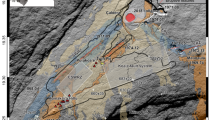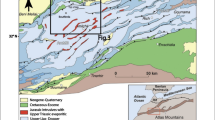Abstract
Incorporating locally varying anisotropy (LVA) in geostatistical modeling improves estimates for structurally complex domains where a single set of anisotropic parameters modeled globally do not account for all geological features. In this work, the properties of two LVA-geostatistical modeling frameworks are explored through application to a complexly folded gold deposit in Ghana. The inference of necessary parameters is a significant requirement of geostatistical modeling with LVA; this work focuses on the case where LVA orientations, derived from expert geological interpretation, are used to improve the grade estimates. The different methodologies for inferring the required parameters in this context are explored. The results of considering different estimation frameworks and alternate methods of parameterization are evaluated with a cross-validation study, as well as visual inspection of grade continuity along select cross sections. Results show that stationary methodologies are outperformed by all LVA techniques, even when the LVA framework has minimal guidance on parameterization. Findings also show that additional improvements are gained by considering parameter inference where the LVA orientations and point data are used to infer the local range of anisotropy. Considering LVA for geostatistical modeling of the deposit considered in this work results in better reproduction of curvilinear geological features.










Similar content being viewed by others
References
Boisvert, J. B. (2010). Geostatistics with locally varying anisotropy. PhD Thesis, University of Alberta.
Boisvert, J. B., & Deutsch, C. V. (2011). Programs for kriging and sequential Gaussian simulation with locally varying anisotropy using non-Euclidean distances. Computers & Geosciences, 37(4), 495–510.
Deutsch, C. V., & Journel, A. G. (1998). GSLIB: Geostatistical software library and user’s guide (2nd ed.). New York: Oxford University Press.
Fouedjio, F. (2015). Space deformation non-stationary geostatistical approach for prediction of geological objects: Case study at El Teniente Mine (Chile). Natural Resources Research, 25(3), 283–296.
Fouedjio, F. (2016). Second-order non-stationary modeling approaches for univariate geostatistical data. Stochastic Environmental Research and Risk Assessment, pp. 1–20.
Fouedjio, F., Desassis, N., & Rivoirard, J. (2016). A generalized convolution model and estimation for non-stationary random functions. Spatial Statistics, 16, 35–52.
Fouedjio, F., Desassis, N., & Romary, T. (2015). Estimation of space deformation model for non-stationary random functions. Spatial Statistics, 13, 45–61.
Fouedjio, F., & Seguret, S. (2016). Predictive geological mapping using closed-form non-stationary covariance functions with locally varying anisotropy: Case study at El Teniente Mine (Chile). Natural Resources Research, 25(4), 431–443.
Lillah, M., & Boisvert, J. B. (2015). Inference of locally varying anisotropy fields from diverse data sources. Computers & Geosciences, 82, 170–182.
Machuca-Mory, D. F., & Deutsch, C. V. (2013). Non-stationary geostatistical modeling based on distance weighted statistics and distributions. Mathematical Geosciences, 45(1), 31–48.
Machuca-Mory, D. F., Rees, H., & Leuangthong, O. (2015). Grade modelling with local anisotropy angles: A practical point of view. In 37th Application of computers and operations research in the mineral industry (APCOM 2015).
Markley, F. L., Cheng, Y., & Crassidis, J. L. (2007). Averaging quaternions. Journal of Guidance, Control and Dynamics, 30(4), 1193–1197.
Martin, R., & Boisvert, J. B. (2017). Iterative refinement of implicit boundary models for improved geological feature reproduction. Computers and Geosciences, 109, 1–15. https://doi.org/10.1016/j.cageo.2017.07.003.
McBratney, S. B., & Minasny, B. (2013). Spacebender. Spatial Statistics, 4, 57–67.
Rossi, M. E., & Deutsch, C. V. (2014). Mineral resource estimation (1st ed., Vol. 1). Springer Science.
Sullivan, J., Satchwell, S., & Ferrax, G. (2007). Grade estimation in the presence of trends—The adaptive search approach applied to the Andina Copper Deposit, Chile. In Proceedings of the 33rd international symposium on the application of computers and operations research in the mineral industry. GECAMIN Ltd. 2007 (pp. 135–143).
te Stroet, C. B. M., & Snepvangers, J. J. J. C. (2005). Mapping curvilinear structures with local anisotropy kriging. Mathematical Geology, 37(6), 635–649.
Xu, W. (1996). Conditional curvilinear stochastic simulation using pixel-based algorithms. Mathematical Geology, 28(7), 937–949.
Acknowledgments
We would like to thank the member companies of the Center for Computational Geostatistics for their support of this research and Golden Star Resources Ltd. for providing data from its Wassa gold project for this study.
Author information
Authors and Affiliations
Corresponding author
Appendix
Appendix
Details of the DWLV Parameter Inference Framework
To extract the LVA ratio’s from the DWLV’s, first a set of anchors are defined by partitioning the domain based on the data density or by considering regions of quasi-constant orientations using an algorithm such as K-means clustering. An orientation for local variogram calculation at each anchor location must be inferred. Machuca-Mory and Deutsch (2013) note that in 2D cases the local orientations can be inferred from the data, but in 3D additional information is required.
Once the anchors and local orientations for each anchor are defined, an experimental variogram is constructed by weighting the square difference of the data pairs by the geometric average of the weights assigned to each sample:
where \( wt_{{c_{i} }} \) and \( wt_{{c_{j} }} \) are the weights based on the distance between the samples locations \( {\mathbf{u}}_{i} \) and \( {\mathbf{u}}_{j} \) to the current anchor c. These weights can be inverse-distance weights (IDW) or weights from a Gaussian kernel centered on c. It should be noted that weighting from Gaussian kernels provides a more continuous and stable weighting of data between anchor locations (Machuca-Mory and Deutsch 2013). The weighted variogram for each anchor \( {\mathbf{c}} \) and for each lag \( {\mathbf{h}} \) is calculated as (Machuca-Mory and Deutsch 2013):
All distances refer to the Euclidean distance, and \( |{\mathbf{u}}_{\varvec{i}} - {\mathbf{u}}_{\varvec{j}} | \cong \left| {\mathbf{h}} \right| \). The constructed experimental variograms can be fit manually or semiautomatically to determine the local range of anisotropy (and ratios) at each anchor location. The final fitted ratios can then be interpolated smoothly throughout the domain using global kriging with a long variogram range or IDW interpolation.
Modified LVA-Pair Matching Algorithm
A modified version of DWLV is proposed where instead of determining a representative local orientation for each anchor location, each data pair is individually classified as along major, minor or vertical directions based on the pair orientation and the LVA orientations found along the lag vector. To obtain the average orientation along the lag vector in 2D vector components may be averaged if the axial nature of the data is accounted for. However, in 3D where the local orientations include a plunge, quaternions are used to determine the average rotated coordinate system (Markley et al. 2007). For every intersected cell along the straight-line path, the rotation angles strike \( \alpha \), dip \( \beta \) and plunge \( \phi \) (ang1, ang2, ang3 from GSLIB conventions) are converted to a quaternion using (Lillah and Boisvert 2015):
and the matrix M is accumulated using the outer product, for all intersected cells, ni, between each data pair (Markley et al. 2007):
Finally, the quaternion representing the average rotated coordinate system is the eigenvector corresponding to the largest eigenvalue from Eigen decomposition of the matrix M (Markley et al. 2007). The set of strike, dip and plunge is recovered using (Lillah and Boisvert 2015):
where \( q_{1} ,q_{2} ,q_{3} \) and \( q_{4} \) are the respective components of the average quaternion.
Examples of pair matching using the LVA field are shown for a simple domain in Figures 11 and 12. The LVA interpretation for this domain is circular with no dip component. Figure 11 shows a slice of the LVA field for a z-value centered at the large yellow point. All pairs that utilize this point are plotted and colored according to their coding as either along the major, minor or vertical directions from this methodology. Pairs in each direction are logically arranged in this LVA field; major pairs are oriented outwards along the direction of largest continuity indicated from the LVA vectors, minor pairs are oriented roughly 90 degrees to the major orientation, and the vertical pairs are above and below the current pair (Fig. 11). Figure 12 shows the straight-line path between a single data pair. LVA intersected in the cells each end of the lag vector is drawn, and the average rotated coordinate system is calculated from the intersected cells. The pair in Figure 12 is coded to the major variogram because the orientation of the lag vector for this pair is coincident with the major axis of the average rotated coordinate system.
Rights and permissions
About this article
Cite this article
Martin, R., Machuca-Mory, D., Leuangthong, O. et al. Non-stationary Geostatistical Modeling: A Case Study Comparing LVA Estimation Frameworks. Nat Resour Res 28, 291–307 (2019). https://doi.org/10.1007/s11053-018-9384-5
Received:
Accepted:
Published:
Issue Date:
DOI: https://doi.org/10.1007/s11053-018-9384-5






